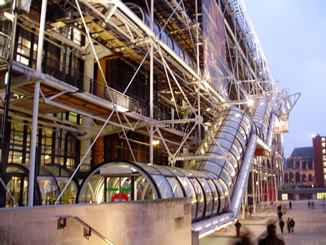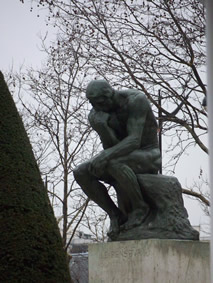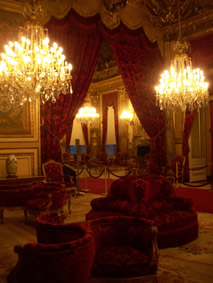Centre Pompidou

The Centre Pompidou holds an amazing collection of contemporary art. The museum’s façade is shocking: a metallic structure with large windows, allowing pedestrians to see within. A large space in front of the museum allows citizens to gather and share. Inside, there are works that exemplify art currents such as fauvism, cubism and surrealism. Some general patterns among these were contrasting colors, the simplification of forms, and a stretching of the definition o art. The latter is perhaps best represented by the work “Fontaine” by Marcel Duchamp, a piece which begs the question: can a simple urinal be a work of art when it is exposed and regarded as such?
-Monica
Musée Rodin


Everything comes with practice and experience. Rodin had natural genius, but even so he spent his life experimenting with new ways to present forms and express emotions through sculpture. For example, he requested that his sculpture “The Bourgeois of Calais” be displayed at ground level, instead of on the customary pedestal. The reduced height allowed the public to inspect the faces of the defeated French noblemen in the sculpture. Also, even the most famous sculptures and painters practiced and learned from one another. Matisse started sculpting later in life, and he was greatly influenced by Rodin. When we viewed their works side by side in the museum, it was obvious the inspiration that Rodin gave to Matisse.
-Vasudha
Musée Carnavalet
This museum was all about the history of the history of Paris, spanning from the medieval times through royalty. The museum largely housed paintings of influential people (i.e. Napoleon, Catherine de Medicis) and events (i.e. the taking of the Bastille), showing the history of Paris through the eyes of people who were actually there. What I found more interesting than just the paintings, however, were the objects from the history of Paris that were scattered throughout the museum. Everywhere there were the chairs of royalty, which you couldn’t sit on (signs were everywhere telling you where you couldn’t sit and what you couldn’t touch) and the personal effects of people like Napoleon, Marie Antoinette, and Madame de Sévigné. The latter was interesting because the museum had many of the letters that she had written to her daughter about everyday life and the people. It was an interesting glimpse into what was really going on in the mid-1600s (when Mme Sévigné wrote her letters).
-Amanda
Louvre

The Louvre was built in the twelfth century and served as the royal residence to the French monarchy before they moved to Versailles in the seventeenth century. It became a museum in the 18th century and is now the world’s largest museum. As we arrived from the Metro, we could see the huge glass pyramids in front of the Louvre above us. Our visit mainly focused on the evolution of sculpture, all the way from Ancient Greece to 19th century France. After that, we each went our own way and explored parts of the museum. They say that it would take 3 years to see everything the Louvre has to offer, and I believe them. Even though we were there all day long we only saw a tiny part of their exhibitions. However, there is one thing you can’t leave without seeing: the apartments of Napoleon III. Talk about extravagant!
-Efrain
Musée d’Orsay
The Musée d’Orsay was originally built as a train station to serve the center of Paris, but as the city (and trains) grew, the site was too small to be useful. In 1986, the building was converted into an art museum, housing works from between 1848, the end of the monarchy, to 1914, the First World War. This time witnessed a fountain of artful innovations. In 1863, Napoléon III opened the Salon des Refusés. Here were displayed all the works of art that the emperor had officially rejected. He opened the salon as a way to justify the dismissal, to say to the public, “Can you believe how outrageous these artists are?” Instead, the salon popularized the rejected works and united the rejected artists. Soon, the artists began displaying their work independently, an unheard of action. Thus Napoléon cleared the way for scandalous paintings such as Édouard Manet’s “Déjeuner sur l’herbe,” which showed a nude woman picnicking in the presence of two men, and for the much-acclaimed impressionists such as Claude Monet, Pierre-Auguste Renoir, and Paul Cézanne.

Out of all the museums we visited, the Musée d’Orsay contained my favorite art, pieces by Vincent van Gogh and Paul Gaugin. When we toured the Centre Pompidou, our tour guide Anne told us that by painting abstractly or distorting features or exaggerating the colors, artists try to represent their subjects as they are, not just as what they look like—to capture the emotion and essence. Van Gogh’s swirling colors and Gaugin’s clean lines recognizably depict a subject, but distort and simplify the image to make it more powerful.


-Ashley
Musée Des Arts Forains
Musée Des Arts Forains


Let’s state the obvious: our tour guide was a little theatrical, a little out there, a little too much fun—but her peculiarities enhance the ambiance of the carnival that the museum preserved. Movement is closely related to time, but this city has does a wonderful job in holding things completely still in time. At this museum, we were able to ride on carousels and rides that were many, many years old. We saw entire sets and displays from carnivals courtesy of our guide, who, though a little eccentric, added so much to our experience of really feeling a part of this theater.
– Vasudha
Musée Des Arts et Métiers
This was definitely one of my favorite museums of the trip. You first walk in and are confronted with not only rows of bicycles that I had only seen in movies, but with a real Ford Model T. Going through the museum there were examples of old spinning looms, gears, sewing machines, and airplanes. Toward the end of the trip through more contemporary, but still archaic to our modern eyes, machines were displayed including old microscopes, a real Apple II (Apple Lisa II), a teletype, an old IBM supercomputer. Following the museum all the way to the end showed the international competition currently going on to build the next great scientific advance, which is currently, according to the museum, the next best (largest) particle collider. It was pretty amazing to see the development of transportation and industrial/scientific equipment from very early (1600s) right up to the current day. It was also very interesting to see another country’s perspective on technological competition.
– Amanda
